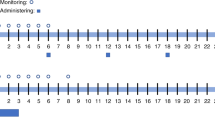Abstract
Busulfan (BU) is included in many conditioning protocols for haematopoietic stem cell transplantation (HSCT). Pharmacokinetic parameters in individual patients have been related to short-term toxicity and risk of relapse after HSCT. In a series of 11 patients receiving the usual 16 × 1 mg/kg schedule over 4 days, we investigated the pharmacokinetics of replacing one dose with an intravenous formulation (BU in DMSO) which we had previously investigated in dogs. A dose of 0.5–0.6 mg/kg was used. No acute side-effects of BU/DMSO infusions administered over 1 h were observed. Bioavailability of BU powder capsules was on average 70% (range, 44–94%). Interindividual variability of the resulting AUC after intravenous doses was still substantial. Further studies are under way to define the possible role of BU/DMSO infusions in conditioning before HSCT.
Similar content being viewed by others
Author information
Authors and Affiliations
Rights and permissions
About this article
Cite this article
Schuler, U., Ehrsam, M., Schneider, A. et al. Pharmacokinetics of intravenous busulfan and evaluation of the bioavailability of the oral formulation in conditioning for haematopoietic stem cell transplantation. Bone Marrow Transplant 22, 241–244 (1998). https://doi.org/10.1038/sj.bmt.1701322
Received:
Accepted:
Published:
Issue Date:
DOI: https://doi.org/10.1038/sj.bmt.1701322
- Springer Nature Limited
Keywords
This article is cited by
-
Comparison of Two Analytical Methods for Busulfan Therapeutic Drug Monitoring
European Journal of Drug Metabolism and Pharmacokinetics (2021)
-
Monitoring of Busulphan Concentrations in Children Undergone Hematopoietic Stem Cell Transplantation: Unicentric Experience over 10 years
European Journal of Drug Metabolism and Pharmacokinetics (2018)
-
Effect of age on the pharmacokinetics of busulfan in patients undergoing hematopoietic cell transplantation; an alliance study (CALGB 10503, 19808, and 100103)
Cancer Chemotherapy and Pharmacology (2014)
-
Exposure equivalence between IV (0.8 mg/kg) and oral (1 mg/kg) busulfan in adult patients
European Journal of Clinical Pharmacology (2009)
-
Overexpression of glutathione S‐transferase A1‐1 in ECV 304 cells protects against busulfan mediated G2‐arrest and induces tissue factor expression
British Journal of Pharmacology (2002)




